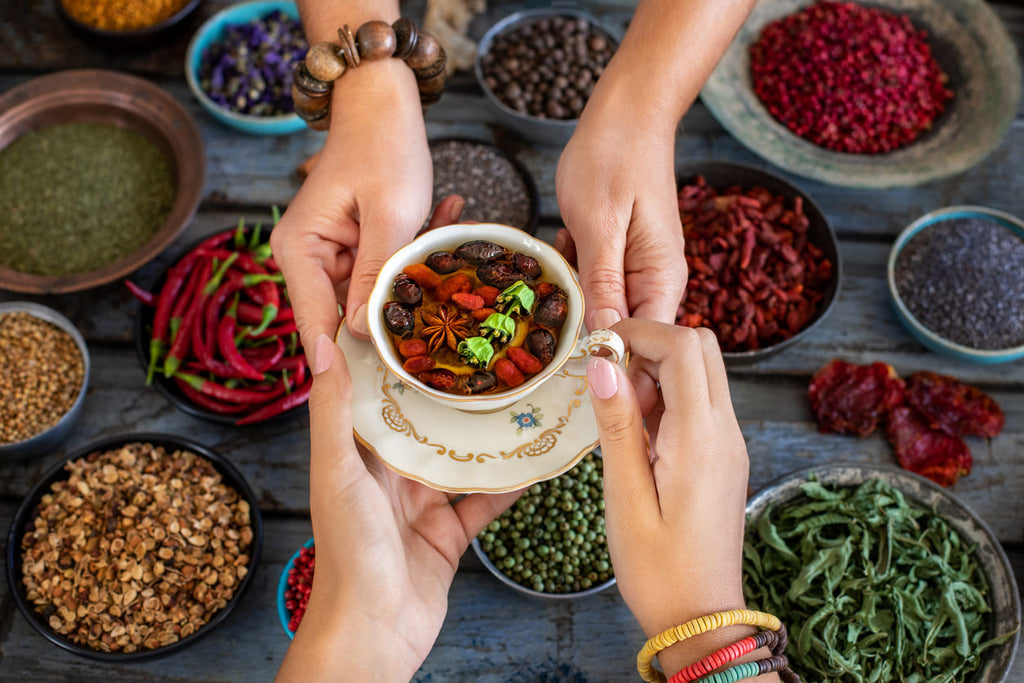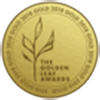Crafting the Perfect Blend: How Local Spices Enhance Tea Flavours

lucA cup of tea is so much more than just a beverage. It's an important ritual that offers a sense of comfort, connection, multiple health benefits and is a soothing way to start or end your day. In some countries, tea drinking is part of deep cultural traditions, including customary ceremonies, hospitality or for meditation purposes. But whether you always drink your tea alone, or prefer your beverage with company, one of the greatest things about a cup of tea is the multiple variations available to suit a range of tastes and preferences. As well as selecting from a range of teas, we also have the luxury of creating spiced tea blends using all natural ingredients such as flowers, herbs and spices to create unique and interesting flavours as well as boosting our natural wellness. In this guide, we will discuss the types of tea available, and how the role of spices enhances not only the flavour but supports our body's health and wellbeing. And finally, we will share with you our secret to brewing the perfect cup of tea, every single time.
Drinking Tea is a Historical Tradition
Originating in China, the ritual of tea drinking has been around for thousands of years. With its cultural history, delicious flavours and health benefits, it's really no surprise that tea is one of the most popular beverages globally. Here's why we think it's one of the best:
- Social opportunities
Who doesn't love to share a cup of tea with a family member or friend? As well as it being an excellent centrepiece for social connections, the importance of this runs much deeper within certain cultures. For example, Japan view tea as an opportunity to practise mindfulness, whether that be collectively or independently, whilst in China, tea takes pride of place for social gatherings.
- Variety of flavours
There are of course a range of teas to choose from, which enables everyone to find the cup that is right for them. From smoky, nutty tastes to floral and fruity flavours, tea really is the drink to suit every palate. How many variations have you tried?
- Promotes natural wellness
There are multiple and diverse health benefits to drinking your favourite beverage. For example, black tea supports heart health, green tea boosts your metabolism and brain function, whilst herbal teas work wonders for your digestion, immune system and help the body to relax and unwind.
- Natural caffeine boost
Unlike coffee, tea provides a wonderful lift in energy without the negative side effects such as nasty headaches and unwanted jitters.
- A ritual like experience
Drinking tea is much like a tradition, whether it's as simple as popping the kettle on the very moment you wake up, to more traditional and historical methods such as being part of a cultural ceremony, tea drinking takes a large role in most of our lives.
- Brightens one's mood
Some say that answer to just about everything is a cup of your favourite tea. Whether you've had some bad news, celebrating a new milestone, or generally feeling under the weather, a cup of tea is never an unwelcome accompaniment. Some even use tea to warm their bones or heal sore throats and stomachs.
H2: The Many Forms of Tea
There are many different types of tea for us to enjoy, each with their own flavour and health advantages. Below we have listed the various forms of tea and their characteristics:
- Black
Black tea is arguably the most popular and contains the most caffeine compared to other tea variants. Black tea gives off its dark colour and strong flavour as the leaves of the Camellia plant are fully oxidised. Its caffeine substance provides a great energy boost, and the drink also supports heart health and digestion. The most common black teas are English breakfast and Earl Grey.
- White
Also made from the Camellia plant, white tea's prominent feature is that it is the least processed of all the tea variants. This means that there is a very little caffeine percentage as well as a delicate taste. Some individuals welcome the reduced caffeine content, as well as enjoying the sweet, floral drink for its high level of antioxidants. White teas you may recognise are white peony and silver needle.
- Green
Another tea harvested from the Camellia Plant, green tea is distinguishable as it is unoxidised and of course, because of its vivid colour. Popular green teas such as matcha and dragon well are celebrated because of their ability to boost metabolism and support brain function.
- Herbal
Herbal tea is unique in the fact that it isn't made with tea leaves. Instead, dried fruits, flowers and herbs are used to create a vast range of interesting flavours. Herbal teas do not contain caffeine and often taste fruity or sweet. Popular varieties of this tea include peppermint, chamomile and hibiscus. Each variety of herbal tea comes with its own advantages, but generally they are full of antioxidants, support digestion and have a calm and relaxing effect.
- Oolong
Sitting somewhere in the middle in relation to its caffeine content, oolong tea can come in multiple forms and flavours depending on its oxidation levels. Benefits of oolong tea include enhanced focus and improved gut health. You may be familiar with dan chong and ti kuan yin varieties.
- Rooibos
Red or green rooibos contain no caffeine as it's created from the rooibos plant, but is well-loved due to its earthy taste, high levels of antioxidants and its ability to support a healthy heart.
Loose Leaf vs Tea Bags
Once you've decided on the type of tea you'd like to drink, you also have the option of selecting loose leaf or tea bags. There are of course pros and cons for both, and many tea drinkers have their preferred variation. We have listed these below:
- Loose leaf
One of the great advantages of loose leaf tea is that the quality of the leaf is generally greater than in tea bags, meaning that the taste is also more prominent. Additionally, you can often reuse the leaves multiple times without compromising on flavour. It is however fiddlier and time-consuming to make, whilst also requiring additional tools such as tea strainers.
- Tea bags
Tea bags are specifically designed with the correct portion of leaves, which means making tea quickly or on the go is a breeze. The brewing time is also typically faster, but the strong flavour may be compromised by the paper bags they are held in.
Spiced Tea Blends and Their Benefits
Adding spices to tea is a much-loved ritual for many, as they enrich the flavour immensely and also provide wonderful health benefits. Here's our non-exhaustive list of natural ingredients to create the most perfect Spiced Tea Blends:
- Ginger
Infusing your tea with ginger will give it a welcomed spicy kick, if you can handle it! Many choose to add ginger to their tea for its immune boosting qualities.
- Cinnamon
Cinnamon provides a sweetness to your drink and is the perfect choice for a cold and blustery day. Cinnamon also offers anti-inflammatory benefits.
- Turmeric
Also known for its anti-inflammatory qualities, individuals combine turmeric with their tea to add a warm, earthy taste.
- Black pepper
Black pepper is the perfect addition if you love a bit of heat and earthy spice. Its benefits include supporting the immune system, digestion and metabolism.
- Cardamom
One for the citrus lovers, cardamom adds this flavour along with supporting your digestive system.
- Clove
Clove adds a richness to your tea whilst also being celebrated for its all-natural antibacterial attributes.
- Nutmeg
A sweet and nutty choice, nutmeg relieves bloating, promotes sleep and has anti-inflammatory properties.
- Vanilla
Vanilla adds a deliciously creamy touch to your tea, reduces stress, supports digestion and settles upset stomachs.
How to Brew the Most Perfect cup of Loose Leaf Spiced tea
So, now we've discussed the different types of tea, and the selection of species you can add to enhance flavour and improve your natural wellness. It's only right that we share our wisdom on how to make the most perfect cup of loose leaf tea. We can guarantee you'll never look back after trying this method:
- Choose your base tea (approximately 70%).
- Select your favourite spice (approximately 30%).
- Add a third flavour if you fancy (approximately 10% if using).
- Boil the correct amount of fresh water in a kettle or over a stove.
- Warm your teapot by swilling some of the water in the kettle, then pour it away.
- Add your chosen tea leaves to the pot or infuser. We recommend 1 teaspoon of leaves per cup of water.
- Add the remaining hot water over the leaves and brew (approximately 3-5 minutes for black tea and 5 or more for herbal teas).
- When ready, remove your strainer or pour straight from your tea pot into your preferred mug.
- To enhance the taste further, consider adding milk or honey.
It's important to remember that tea drinking is personal and unique to each individual. Why not experiment with flavours, ratios and brewing time until you find your perfect balance?
Spiced Tea Blends - The Possibilities are Endless
As you can see, there really are countless ways you can enrich your everyday cup of tea with the help of local spices. Not only do they enhance the flavour, but adding spice to your drink will also provide you with multiple health benefits. Once you've exhausted our spice tea blend recommendations, have you considered custom tea blends and other natural ingredients such as herbs, fruits and flowers?
- Lucas Ruzicka







Comments 0